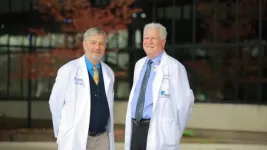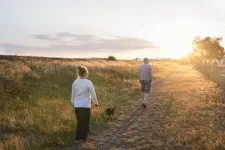A new way to measure human wellbeing towards sustainability
2021-03-16
(Press-News.org) From science to implementation: How do we know if humankind is moving in the right direction towards global sustainability? The ambitious aim of the SDGs is a global call to action to end poverty, protect the planet, and ensure all people enjoy peace and prosperity by 2030. To monitor progress towards these goals, a set of over 220 indicators is used, but there is a danger that one can no longer see the forest for the trees. A single comprehensive indicator to assess the overall progress is needed. In a new paper published in the Proceedings of the National Academy of Sciences (PNAS), IIASA researchers and colleagues from the University of Vienna, the Vienna Institute of Demography (Austrian Academy of Sciences), and the Bocconi University present a bespoke indicator based on life expectancy and benchmarks of objective and subjective wellbeing: The Years of Good Life (YoGL) indicator.
"Many existing indicators of wellbeing do not consider the basic fact that being alive is a prerequisite for enjoying any quality of life. In addition, they often disregard the length of a life. Life expectancy has long been used as a very comprehensive indicator of human development, with avoiding premature death being a universally shared aspiration. However, mere survival is not enough to enjoy life and its qualities," explains lead author Wolfgang Lutz, Founding Director of the Wittgenstein Centre for Demography and Global Human Capital, a collaborative center of the Austrian Academy of Sciences (Vienna Institute of Demography), International Institute for Applied Systems Analysis, and University of Vienna. "The Years of Good Life indicator only counts a year as a good year if individuals are simultaneously not living in absolute poverty, free from cognitive and physical limitations, and report to be generally satisfied with their lives."
The results show that YoGL differs substantially between countries. While in most developed countries, 20-year-old women can expect to have more than 50 years of good life left (with a record of 58 years in Sweden), women in the least developed countries can expect less than 15 years (with a record low of 10 years for women in Yemen). While life expectancy is higher for women than for men in every country, female Years of Good Life are lower than those of males in most developing countries. This reveals a significant gender inequality in objective living conditions and subjective life satisfaction in most of these countries.
The paper - funded by an Advanced Grant to Lutz from the European Research Council - presents a first step in the great challenge to comprehensively assess sustainable human wellbeing that also considers feedbacks from environmental change. Unlike many other indicators, YoGL is not restricted to the national level but can be assessed for flexibly defined sub-populations and over long-time horizons because it has substantive meaning in its absolute value. It also has the potential to become a broadly used "currency" for measuring the benefits of certain actions, complementing assessments based on purely monetary units. For example, the social costs of carbon could potentially be evaluated in terms of Years of Good Life lost among future generations, rather than only in dollar terms - making it a key indicator to measure sustainable progress in an integrated and tangible way. Applying the same logic to the recent COVID-19 pandemic, study coauthor Erich Striessnig adds that YoGL also represents a major improvement over conventional indicators in assessing the long-term success of intervention measures.
"If we used YoGL as a currency to measure the long-term impacts of the ongoing crisis rather than GDP per capita or life expectancy, we would not only account for the material losses and the lost life years, but also for the losses in physical and cognitive wellbeing, as well as for the losses incurred by the younger generations in terms of their human capital resulting from school closures. Lack of consistent data that is needed to calculate YoGL does of course remain an issue. Political decision makers should, however, aim for improved data availability to make better informed decisions based on indicators such as YoGL," Striessnig concludes.
INFORMATION:
Reference
Lutz, W., Striessnig, E., Dimitrova, A., Ghislandi, W., Lijadi, A., Reiter, C., Spitzer, S., Yildiz, D. (2021). Years of Good Life (YoGL) is a wellbeing indicator designed to serve research on sustainability. Proceedings of the National Academy of Sciences (PNAS) DOI: 10.1073/pnas.1907351
Contacts:
Researcher contact
Wolfgang Lutz
Senior Program Advisor
Population and Just Societies Program
Acting Research Group Leader
Social Cohesion Health and Wellbeing Research Group
+43(0) 2236 807 294
lutz@iiasa.ac.at
Press Officer
Bettina Greenwell
IIASA Press Office
Tel: +43 2236 807 282
greenwelll@iiasa.ac.at
About IIASA:
A close up of a logo
Description automatically generated
The International Institute for Applied Systems Analysis (IIASA) is an international scientific institute that conducts research into the critical issues of global environmental, economic, technological, and social change that we face in the twenty-first century. Our findings provide valuable options to policymakers to shape the future of our changing world. IIASA is independent and funded by prestigious research funding agencies in Africa, the Americas, Asia, and Europe.
http://www.iiasa.ac.at
ELSE PRESS RELEASES FROM THIS DATE:
2021-03-16
Researchers from Louisiana State University have introduced a smart quantum technology for the spatial mode correction of single photons. In a paper featured on the cover of the March 2021 issue of Advanced Quantum Technologies, the authors exploit the self-learning and self-evolving features of artificial neural networks to correct the distorted spatial profile of single photons.
The authors, PhD candidate Narayan Bhusal, postdoctoral researcher Chenglong You, graduate student Mingyuan Hong, undergraduate student Joshua Fabre, and Assistant Professor Omar S. Magaña?Loaiza of LSU--together with collaborators Sanjaya Lohani, Erin M. Knutson, ...
2021-03-16
ITHACA, N.Y. - Using light from the Big Bang, an international team led by Cornell University and the U.S. Department of Energy's Lawrence Berkeley National Laboratory has begun to unveil the material which fuels galaxy formation.
"There is uncertainty on the formation of stars within galaxies that theoretical models are unable to predict," said lead author Stefania Amodeo, a Cornell postdoctoral researcher in astronomy in the College of Arts and Sciences, who now conducts research at the Observatory of Strasbourg, France. "With this work, we are providing tests for galaxy formation models to comprehend galaxy and star formation."
The research, "Atacama Cosmology Telescope: Modeling the Gas Thermodynamics ...
2021-03-16
CHAMPAIGN, Ill. -- Agricultural scientists who study climate change often focus on how increasing atmospheric carbon dioxide levels will affect crop yields. But rising temperatures are likely to complicate the picture, researchers report in a new review of the topic.
Published in the Journal of Experimental Botany, the review explores how higher temperatures influence plant growth and viability despite the greater availability of atmospheric CO2, a key component of photosynthesis.
Excessive heat can reduce the efficiency of enzymes that drive photosynthesis and can hinder plants' ability to regulate CO2 uptake and water loss, the researchers write. Structural features can make plants more - or less - susceptible to heat stress. Ecosystem attributes - such as the size ...
2021-03-16
The symptoms of postural orthostatic tachycardia syndrome, or POTS, can be as varied as they are confounding.
There can be fatigue, pain, bleeding disorders and anxiety. Heart palpitations and lightheadedness are common. Some patients experience gastrointestinal issues or brain fog. For the most severely affected, the simple act of standing up can send them crumpling into unconsciousness.
Though likely much more common than once thought, POTS remains something of a mystery. Many physicians have never heard of it. There's no lab test to confirm a diagnosis and no treatment to cure the condition.
That could all be ...
2021-03-16
The hummingbird is named after its pleasant humming sound when it hovers in front of flowers to feed. But only now has it become clear how the wing generates the hummingbird's namesake sound when it is beating rapidly at 40 beats per second. Researchers from Eindhoven University of Technology, Sorama, a TU/e spin-off company, and Stanford University meticulously observed hummingbirds using 12 high-speed cameras, 6 pressure plates and 2176 microphones. They discovered that the soft and complex feathered wings of hummingbirds generate sound in a fashion ...
2021-03-16
Tsukuba, Japan - Fungi are a vital part of nature's recycling system of decay and decomposition. Filamentous fungi spread over and penetrate surfaces by extending fine threads known as hyphae.
Fungi that cause disease within living organisms can penetrate the spaces between tightly connected plant or animal cells, but how their hyphae do this, and why the hyphae of other fungal species do not, has been unclear.
Now, a team led by Professor Norio Takeshita at University of Tsukuba, with collaborators at Nagoya University and in Mexico, has discovered a key feature that helps explain the differences among species. They compared seven fungi from different taxonomic groups, including some ...
2021-03-16
Washington, D.C. - March 16, 2021 - For the first time, researchers have isolated the fungus Candida auris from a sandy beach and tidal swamp in a remote coastal wetland ecosystem. The discovery, reported this week in mBio, an open-access journal of the American Society for Microbiology, represents the first evidence that the pathogen thrives in a natural environment and is not limited to mammalian hosts. C. auris can cause infections resistant to major antifungal drugs, and since its identification in clinical patients 10 years ago scientists have sought to understand its origins.
A ...
2021-03-16
SLOW walkers are almost four times more likely to die from COVID-19, and have over twice the risk of contracting a severe version of the virus, according to a team of researchers from the National Institute for Health Research (NIHR) Leicester Biomedical Research Centre led by Professor Tom Yates at the University of Leicester.
The study of 412,596 middle-aged UK Biobank participants examined the relative association of body mass index (BMI) and self-reported walking pace with the risk of contracting severe COVID-19 and COVID-19 mortality.
The analysis found slow walkers of a normal weight to be almost 2.5 times more likely to develop severe COVID-19 and 3.75 times more likely to die from the virus ...
2021-03-16
Boston, Mass. - Just one year after the World Health Organization declared the novel coronavirus a global pandemic, three COVID-19 vaccines are available in the United States, and more than 2 million Americans are receiving shots each day. Americans are eager to get back to business as usual, but experts caution that opening the economy prematurely could allow a potential resurgence of the virus. How foot traffic patterns in restaurants and bars, schools and universities, nail salons and barbershops affect the risk of transmission has been largely unknown.
In an article published ...
2021-03-16
LA JOLLA, CALIF. - March 16, 2021 - A Nature study authored by scientists at Sanford Burnham Prebys Medical Discovery Institute and the University of Hong Kong shows that the leprosy drug clofazimine, which is FDA approved and on the World Health Organization's List of Essential Medicines, exhibits potent antiviral activities against SARS-CoV-2 and prevents the exaggerated inflammatory response associated with severe COVID-19. Based on these findings, a Phase 2 study evaluating clofazimine as an at-home treatment for COVID-19 could begin immediately.
"Clofazimine is an ideal candidate for a COVID-19 treatment. It is safe, affordable, easy to make, taken as a pill and can be made globally available," ...
LAST 30 PRESS RELEASES:
[Press-News.org] A new way to measure human wellbeing towards sustainability





